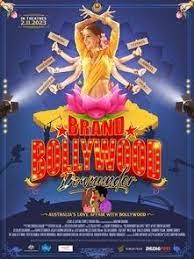
BRAND BOLLYWOOD… down under
Australia, 2023, 93 minutes, Colour.
Directed by Anupam Sharma.
An interesting and entertaining documentary, especially for movie buffs, but beyond… A subtitle: Australian’s love affair with Bollywood.
The screenplay points out that the biggest group of migrants to Australia after the British is the Indian migration. Which means that this is a documentary both for Australia and for India.
In fact, the film has three special focal points. First, there is cinema itself. Secondly, issues of trade and tourism between the two nations. And, thirdly, issues of culture and cross culture. And, within its hour and a half, all of these issues are dramatised and challenged.
The director himself, Anupam Sharma, of Indian background, graduated from the University of New South Wales, has been involved in the film industry since the 1990s, as producer, and director of several films including the Brett Lee cricket comedy, UNindian.
And on the title – for decades now, Bollywood is the general title for Indian cinema (and, it is rightly pointed out that this is not accurate, applying to Mumbai cinema and its singing and dancing style, but not really applicable to cinema from such centres as Kolkota, Chennai,). But, there are plenty of excerpts from Bollywood movies throughout the film – and quite a long final credits song and dance to keep us in the mood.
Indian culture has been for millennia a culture of images, paintings, statuary. And, very early in the history of contemporary cinema, Indian filmmakers realised its potential. The first 30 minutes of this film offers a very interesting, sometimes illuminating, history of cinema in India, quite striking silent film footage and, for Australians, the story of Mary Ann Evans from Perth who went from Australia to India, worked in and circus, and in the 30s became quite a movie superhero figure, Fearless Nadia (and clips from her films to definitively prove this).
Indian filmmakers had come to Australia but this developed during the latter part of the 1990s, again many clips to highlight the scenarios, and Indian characters photographed often on Sydney Harbour Bridge, in the outback, with kangaroos…
Which leads to the second issue of trade and tourism, Indian audiences fascinated by what they saw with the movies made in Australia, wanting to visit. And, with the filmmaking, possibilities for trade and industry development. To highlight this, South Australian Labor Premier, Mike Rann, invited India to South Australia and, for a time, a centre for India-Australia films. But then the emphasis moved to Victoria, especially with Liberal Premier Ted Baillieu, enthusiastically welcoming India – and both Premiers persuaded to join dances on stage and display the rhythmic movements!
There is also the issue of Intermission, always during Indian screenings for some mid--movie socialising.
So, a great deal of cross-cultural interactions. But, a number of tensions. Filmmaking style in Indian studios seems loud, brash, everybody involved, contrasting with a more disciplined practical approach in Australian studios. But, the film also emphasises some sad events in Australia, murders of Indian students in Australia, media attacks on Australia, doyen of Indian actors, Amitabh Bachchan, publicly refusing an honorary degree from the University of Queensland (but, with more dialogue and more collaboration, accepting the degree eventually and coming to Australia for a cameo in Baz Luhrmann’s The Great Gatsby).
There is a Bollywood festival in Australia. Many cinemas program Indian films – and there is no lack of films from India which has the largest film industry in the world.
So, an urge to creative cinema collaboration.